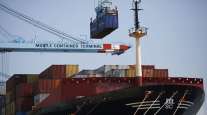Staff Reporter
Intermodal Volume Growth in 2018 Best in Five Years, IANA Report Says

Driven by tight trucking capacity and the threat of tariffs, intermodal volumes increased 5.6% in 2018, their highest growth in five years, according to the Intermodal Association of North America’s annual report.
“Not only were gains substantial, they were also broad-based,” the report said. “All markets recorded an increase of at least 4.9% or greater, and all regions saw traffic climb.”
Intermodal trailers saw the largest increase of any segment, rising 10.6% year-over-year, IANA reported.
Hot off the press: Intermodal Nets Solid Growth in Fourth Quarter https://t.co/PRWauAUj3G
— IANA (@Intermodal) February 1, 2019
At the end of 2017, 17.9 million trailers, containers and other equipment were shipped intermodally. A year later, that number jumped to 18.9 million.
The surge had a variety of causes. For one, shipments began pouring into the West Coast to beat new tariffs that President Donald Trump may add, the report said.
“Throughout 2018, there has been speculation that freight may have been pushed forward to avoid tariffs on Chinese imports,” according to the report. “October and December import volumes seem to support this theory.”
Another cause was tight trucking capacity, which will be better in 2019, but intermodal volumes still will grow, the report said.
“Intermodal growth likely will continue in 2019 but a bit slower than 2018’s 5.6% gain,” the report said. “There is some risk from potential trade wars, an extended government shutdown and a significantly tight labor market."
Also, trucking capacity is expected not to be as tight in 2019 compared to 2018, a major factor for intermodal growth. Still, the intermodal market has risen close to 5% per year since the 2016 freight recession.
Yet before the report came out Feb. 1, there already was talk about growth.
During the Jan. 22 earnings report, J.B. Hunt Transport Services Inc. officials noted that intermodal rates might outpace trucking rates.
“One of the things we are starting to see is a bigger need for transload in the West Coast,” said Terrence Matthews, president of J.B. Hunt’s Intermodal division. “We’ve heard from the ocean carriers, railroads, and seen it early in the bids. There seems to be more transloading, which will support pricing power off the West Coast.”
This demand could mean an unusual trend in pricing.
“I think you could see a scenario where intermodal rates could be higher at the end of the year in terms of overall rate increases than truck, which is different than what we saw in 2018,” Matthews said.
J.B. Hunt executives said they saw intermodal revenue per load increase to $2,463 from $2,129 due to those higher rates.
A week after the conference call, Matthews and Jeff Heller, vice president of intermodal and automotive at Norfolk Southern Corp., discussed intermodal trends and challenges at SMC3’s annual conference held in Atlanta Jan. 28-30.

Norfolk Southern trains. (Luke Sharrett/Bloomberg News)
Heller noted the disruption that full implementation of electronic logging devices has had on intermodal and, in particular, on shipping in the Midwest. New regulations have turned a one-day shipping trip from Chicago to Columbus, Ohio, into two days of work. That problem caused some shippers to turn to intermodal methods.
“It had a significant impact,” Heller told the audience of 550 trucking and logistics officials. “It seems now to be normalized.”
Matthews said the new demand has caused freight companies to try to force more throughput through the same terminal footprint, leading to his concern about terminal capacity.
Another concern for J.B. Hunt has been the driver shortage, which is particularly pronounced for short drayage trips of about 250 miles, Matthews told SMC3 attendees.
He said J.B. Hunt has raised driver wages in the Midwest between $12,000 and $15,000 a year, something he has not seen in his career. The result was 30% of its new drivers had not had a driving job within 90 days, meaning some drivers had been pulled back into the industry.




